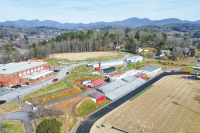The Naturalist's Corner: Breath still bated
Maybe it’s March Madness, maybe it’s simply madness, but I’m looking at the Lake Junaluska eagles and thinking “they’re gonna pull it off.” I made a quick drive-by the other morning during that last cold snap, March 22 I think, and was happy to see a bird on the nest. I have had “eagle neighbors” report an eagle on the nest almost every time they look up. And there are “eagle neighbors” with binoculars, eagle neighbors with spotting scopes and “eagle neighbors” close enough to just look up and watch.
The Naturalist's Corner: Lake J eagles
Most readers know the pair of bald eagles that nested at Lake Junaluska this spring were unsuccessful. There is no way to know the reason for nest failure. It could simply be this was a young inexperienced pair — once eagles attain adult plumage there is no visual clue to determine age. It could have been some kind of predator, but this seems unlikely because that would have created quite a ruckus and the eagles’ next-door, human neighbors would have probably noticed.
Fingers still crossed
Status of the Lake Junaluska eagles remains a mystery, but I still have my fingers crossed for a successful nesting venture. There was some disturbance near the nest a week or so ago — tree trimming on adjacent property — and for a day or two it seemed the eagles were MIA.
The eagles have landed
The eagles’ neighbors have known for months, observant birders and other Lake Junaluska regulars have either known or suspected, and I have sat on the news for a while as I consulted with North Carolina Wildlife Resources Commission (NCWRC) and U.S. Fish & Wildlife, but those two beautiful, large brown raptors with the white heads and tails that have been patrolling the lake regularly for the past few months are, indeed, Lake Junaluska residents.
The Naturalist's Corner: Will eagles dare?
A pair of mature bald eagles has been hanging out at Lake Junaluska for a few months now. I have heard two separate reports of these birds carrying nesting material. In the dark musty cobweb covered labyrinth that serves as my memory, I seem to remember reading about bald eagles nesting on Waterville (Walters) Lake, along the Pigeon River in northwest Haywood County near the Tennessee border back in the late 1970s. However, I recently did a Google search and could find no reference, so? Maybe some reader(s) could clear that up for me?
The eagle lady: Mager, preparing to leave N.C., reflects on 51 years of life with raptors
 Doris Mager returned from her most recent doctor appointment with some grim marching orders. Her instructions didn’t have anything to do with blood pressure problems, cardiac health, nutritional deficiencies or an impending diagnosis. In fact, the doctor said, for 89 years old she was in amazing health.
Doris Mager returned from her most recent doctor appointment with some grim marching orders. Her instructions didn’t have anything to do with blood pressure problems, cardiac health, nutritional deficiencies or an impending diagnosis. In fact, the doctor said, for 89 years old she was in amazing health.
But something had to change.
“My doctor said, ‘Doris you really need to sleep in your house,’” Mager recounted. “I said, ‘But I don’t want to.’ She said, ‘But you really do. It just can’t be good sleeping with the birds.’”
A Golden secret
 There is one winter visitor to our North Carolina Mountains that is probably happy the Blue Ridge Parkway is closed and is not burgeoning with sightseers and thrill-seekers like it is the rest of the year. That visitor would be Aquila chrysaetos canadensis, the North American golden eagle. There is certainly a mystique about this bird, North America’s largest raptor. It is fairly common out West and is thought of as a bird of wide-open areas. But there is a small – 3,000 to 5,000 – population of golden eagles that breed in northeastern Quebec and migrate throughout the Appalachians. This bird, from preliminary research, appears to be a forest dweller that eschews human contact.
There is one winter visitor to our North Carolina Mountains that is probably happy the Blue Ridge Parkway is closed and is not burgeoning with sightseers and thrill-seekers like it is the rest of the year. That visitor would be Aquila chrysaetos canadensis, the North American golden eagle. There is certainly a mystique about this bird, North America’s largest raptor. It is fairly common out West and is thought of as a bird of wide-open areas. But there is a small – 3,000 to 5,000 – population of golden eagles that breed in northeastern Quebec and migrate throughout the Appalachians. This bird, from preliminary research, appears to be a forest dweller that eschews human contact.
The Naturalist's Corner
ake J eagle
Not a winter has passed in the last four years or so that a bald eagle — mature, immature or both — has not been sighted at Lake Junaluska. Usually they’re here today and gone tomorrow, but this winter a visitor has lingered.
A mature bald eagle has been hanging around Lake Junaluska for about a month. Last I heard — last week — it was still there. I believe the drawdown of the lake probably accounts for this bird’s decision to linger.
Eagles around the world are divided into four general groups — fish eagles, harpy or buteonine eagles, true eagles or booted eagles (the golden eagle is in this group) and snake or serpent eagles. The bald eagle, Haliaeetus leucocephalus, is a fish eagle.
A large portion of the bald eagle’s diet, as the name implies, is fish. Another bald eagle staple, especially here in the south in the winter where they tend to congregate in large numbers, is the coot — you know, that gangly dark bird that looks (acts) like a cross between a chicken and a duck, found around the lake in the winter. I believe the drawdown concentrated both of those food sources in small areas making a meal a little easier to come by.
There are two recognized subspecies of bald eagles — northern, Haliaeetus leucocephalus alascanus, and southern, Haliaeetus leucocephalus leucocephalus. The southern bald eagle is a smaller bird and I believe the bird at Lake Junaluska is a southern. Now, bald eagles like most raptors exhibit a “reversed” sexual dimorphism, meaning the female is larger than the male. In some cases, the size difference between a female southern bald eagle and a male northern bald eagle can be minimal, and since southern bald eagles have been found in Canada and northern bald eagles have been found in Mexico, the “southern” moniker is just a guess.
Redefining success
Protection of the bald eagle actually precedes the Endangered Species Act of 1973. The Bald Eagle Protection Act was passed in 1940 and the bald eagle was officially listed as endangered in 1967 under the Endangered Species Act of 1967, the predecessor of the current Endangered Species Act.
There was much fanfare in 2007 when the bald eagle was officially removed from the ESA. The big whoop-de-do at the Jefferson Memorial noted the 40-year, 25-fold increase in nesting pairs of bald eagles in the lower 48 states to an astounding 10,000 pairs. Today it is estimated that there are between 70,000 and 80,000 bald eagles in North America.
Before our forefathers arrived here and cleaned up the desolate old growth forests with their clean air and pristine water to create the urban utopia we know today, more than half a million bald eagles lived in North America.
To restore that population to roughly 15 percent of its former status is a rousing success?
Don Hendershot can be reached at This email address is being protected from spambots. You need JavaScript enabled to view it.





